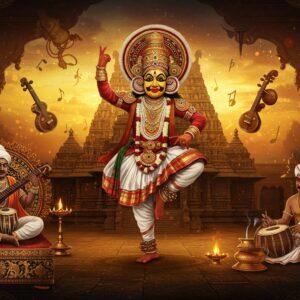
Bhakti Yoga, a profound spiritual practice centered around devotion and love for the divine, holds a significant place in Indian traditions. It offers a transformative path towards connecting with a higher power, fostering universal love that transcends religious boundaries. This path resonates deeply with culturally rooted individuals seeking a stronger spiritual connection. For those embarking on this deeper spiritual journey, understanding the stages of devotion is crucial. The varying descriptions of these stages, often referred to as the Nine Stages of Devotion (Navadha Bhakti), provide a structured approach to Bhakti Yoga.
Exploring the Stages of Bhakti Yoga
Numerous texts, including the Caitanya Caritamrita and Bhakti-rasamrita-sindhu, detail the stages of Bhakti Yoga. These stages represent a gradual deepening of devotion, evolving from an initial spark of faith to a profound and transformative connection with the Divine.
One common framework outlines nine stages:
- Śraddhā (Faith): This is the foundational stage, where the spark of devotion ignites. It involves developing a belief in something beyond the material world and cultivating trust in the divine path. This initial faith sets the stage for the entire journey.
- Sādhu-Saṅga (Association with the Wise): This stage emphasizes the importance of seeking guidance and inspiration from saints, gurus, and fellow devotees. Surrounding oneself with spiritual wisdom fosters growth and deepens understanding.
- Bhajana-Kriyā (Engaging in Devotional Practices): Active participation in devotional practices is key in this stage. Chanting, meditation, studying scriptures, and performing acts of service become integral parts of daily life, shaping and strengthening devotion.
- Anartha Nivrtti (Decreasing Unwanted Attachments): This stage involves consciously working to free oneself from negative habits, attachments, and patterns that hinder spiritual progress. It’s a process of purification and refinement.
- Niṣṭhā (Steadiness): Cultivating steadiness in one’s practice and maintaining focus on self-realization are central to this stage. It’s about developing unwavering commitment and resilience on the spiritual path.
- Ruci (Taste): In this stage, practitioners begin to experience genuine joy and bliss in their devotional practices. Chanting, prayer, and service become deeply fulfilling rather than routine obligations.
- Āsakti (Attachment): This stage involves developing a deeper attachment to divine consciousness, experiencing a growing connection and yearning for the divine presence. It’s a stage of intensifying love and devotion.
- Bhāva (Love): Here, emotions deepen and intensify, leading to the preliminary stage of pure love for the divine. It’s a state of profound emotional connection and surrender.
- Prema (Pure Love): This represents the ultimate stage of Bhakti Yoga, the awakening of pure, unconditional love for the divine. It is the culmination of the journey, a state of complete union and bliss.
Another interpretation, found in texts like the Srimad Bhagavatam and the Vishnu Purana, presents a different set of nine stages:
- Śravaṇa (Hearing): This stage emphasizes the importance of listening to sacred stories and teachings about the divine. Immersing oneself in these narratives lays the foundation for deeper understanding and connection.
- Kīrtana (Singing): Expressing devotion through singing and chanting the glories of the divine is central to this stage. Music becomes a vehicle for spiritual expression and upliftment.
- Smaraṇa (Remembrance): This stage focuses on cultivating constant remembrance of the divine name and presence. Keeping the divine at the forefront of one’s mind strengthens the bond of devotion.
- Pāda-sevana (Service): This stage involves acts of selfless service dedicated to the divine. Serving others and performing acts of devotion with humility are key aspects of this stage.
- Arcana (Worship): Ritualistic worship and offerings to the divine are emphasized in this stage. Engaging in these practices with reverence and sincerity deepens the connection.
- Vandana (Prostration): This stage involves expressing humility and surrender through prostration before the divine. It’s an act of deep respect and acknowledgement of a higher power.
- Dāsya (Servitude): Cultivating the attitude of a servant to the divine is central to this stage. This involves approaching devotion with humility and a willingness to serve.
- Sakhya (Friendship): Developing a sense of friendship and intimacy with the divine is the focus of this stage. It’s about cultivating a personal and loving relationship with the divine.
- Ātma-nivedana (Self-Surrender): The ultimate stage involves complete surrender of the self to the divine will. This represents the culmination of the Bhakti path, a state of complete union and bliss.
Beyond these, the path of aparabhakti presents three distinct phases: the initial honeymoon phase of intense devotion, the challenging desert phase marked by trials and doubts, and finally, the transformative state of surrender and grace.
Deepening Your Practice: Resources and Support
For those seeking to enhance their Bhakti Yoga practice, Poojn.in offers a wide array of resources and products to support your spiritual journey. Whether you’re looking for sacred texts, devotional music, or ritual items, Poojn.in provides a comprehensive collection of authentic and high-quality products to deepen your connection with the divine. From deity statues to incense, you’ll find everything you need to create a sacred space and enhance your devotional practices. Learn more about creating a sacred space for puja and meditation.
Embarking on the path of Bhakti Yoga is a deeply personal and transformative experience. Embrace the journey, cultivate patience and perseverance, and allow the power of devotion to guide you towards self-realization and a profound connection with the divine. Finding a guru can also provide invaluable guidance and support on your spiritual path. Explore Poojn.in’s blog for more insights into Hindu scriptures and spiritual practices.


